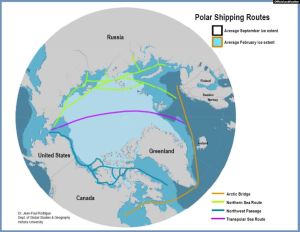 Rosatom to enter market of commercial transshipment via Northern Sea Route in 2027
Rosatom to enter market of commercial transshipment via Northern Sea Route in 2027
It will provide a transit corridor between Northern Europe and East Asia
MOSCOW, November 28. /TASS/. Russia’s state corporation Rosatom plans to start large-scale transshipments between Northern Europe and East Asia via the Northern Sea Route in 2027, according to the website dedicated to the company’s procurements.
Rosatom has initiated the Northern Sea Transit Corridor project, the documents said. The aim is to expand the transit potential of the Northern Sea Route. Its development is planned through providing transshipment services along the Northern Sea Route via transit ports — the hubs on Russia’s western and eastern borders. “The start of commercial operation of the Northern Sea Transit Corridor (start of shipments) is planned for 2027,” the documents read.
There are plans to estimate the prospects of the Northern Sea Transit Corridor’s development in the period between 2027 and 2050 through a marketing research, with a respective tendering procedure having already been launched….
According to the documents, regular marine traffic along the Northern Sea Route is already underway. However, it has to do mainly with the transportation of construction cargoes and exports from Arctic mining projects (Novatek, Rosneft, Gazprom Neft, Lukoil), whereas the transit potential of the Northern Sea Route remains untapped. The development plan for the Northern Sea Route has already been submitted to the Russian government, Deputy Minister for the Development of the Russian Far East Alexander Krutikov said earlier.
For more, read entire article here: https://tass.com/economy/1093735
————————————————————————–
However… according to Polygraph.info in a March 12, 2019 article,
Russia’s New Rules for Northern Sea Route Violate International Law
New Russian rules fully regulating the Northern Sea Route violate the Law of the Sea
The Russian government has developed new rules to control the Northern Sea Route, which passes along the country’s northern coast in the Arctic, the newspaper Izvestia reported on March 6. “Russia is taking the Northern Sea Route under protection,” wrote Izvestia, in a piece headlined “A Cold Wave” – an apparent reference to the Cold War.
Russian officials claim the new regulations are designed to protect the environment and commercial shipping, in lieu (in place of) Article 234 of the United Nations Convention on the Law of the Sea.
In reality, Russia’s new rules concern foreign military ships and military vessels, which are sovereign immune vessels and exempt from Article 234 of the Law of the Sea. Nevertheless, Russia requires foreign military ships and naval auxiliaries to give 45 days’ advance notice and obtain “permission” to use the passage. The document must include the vessel’s name, purpose, route, timetable, and technical specifications, as well as the military rank and identity of its captain. The new Russian rules require that foreign military ships take on board Russian pilots while sailing through the Arctic. Even if the foreign vessels meet all Russia’s requirements, the Russian authorities still can reject their request for passage without explanation. In the event of an unsanctioned passage, the foreign naval vessels could be arrested and even destroyed.
Russia uses the term “Northern Sea Route” (NSR) to describe the area from the Barents Sea in the west to the Bering Strait in the east. It is part of a larger transoceanic route – the Northeast Passage connecting the Atlantic and Pacific oceans.
Like the other Arctic nations, Russia is granted an exclusive economic zone of 200 nautical miles adjacent to its shores. But the scope of the NSR as described by Moscow has been disputed by other Arctic states, which say that Russia considers the route to extend beyond its exclusive economic zone and to include the Bering Strait. Provisions of the Law of the Sea regard international straits as passages that are too narrow for the high sea or exclusive economic zone regimes to apply. Transit passages and innocent passages are fully guaranteed for vessels of other states.
“Indeed, the NSR passes not only within Russia’s territorial waters, nevertheless, our country has the legal right to regulate navigation along the entire route,” said Kamil Bekyashev, vice president of the Russian Maritime Law Association.
Does Russia indeed have the right to impose a permission regime on commercial ships and sovereign immune vessels passing through the Northern Sea Route?
“This statement appears to be out of sync with the Law of the Sea treaty,” Heather Conley, senior vice president of the Center for Strategic and International Studies in Washington, DC, told Polygraph.info. “The Northern Sea Route is an international passage and this suggested wider interpretation may even call into question international use of a portion of the high seas of the Central Arctic Ocean.”
Russia has already heavily regulated commercial traffic through the Northern Sea Route, and in May 2015, the U.S. State Department sent a strongly-worded diplomatic note to Moscow warning that some aspects of Russia’s regulatory scheme were “inconsistent with international law.”
The State Department cited requirements to obtain Russia’s permission to enter and transit the exclusive economic zone and territorial sea; persistent characterization of international straits that form part of the Northern Sea Route as internal waters; and the lack of any express exemption for sovereign immune vessels.
Moscow justifies its regulation of commercial traffic by pointing to Article 234 of the United Nations Convention on the Law of the Sea, which allows coastal states “to adopt and enforce non-discriminatory laws and regulations for the prevention, reduction and control of marine pollution from vessels in ice-covered areas within the limits of the exclusive economic zone.”
(Washington disagrees. Read entire article for rest of this story: https://www.polygraph.info/a/fact-check-russia-claim-arctic/29817535.html)
Also please see:
https://tapister.wordpress.com/2013/10/11/northwest-passage/
You must be logged in to post a comment.